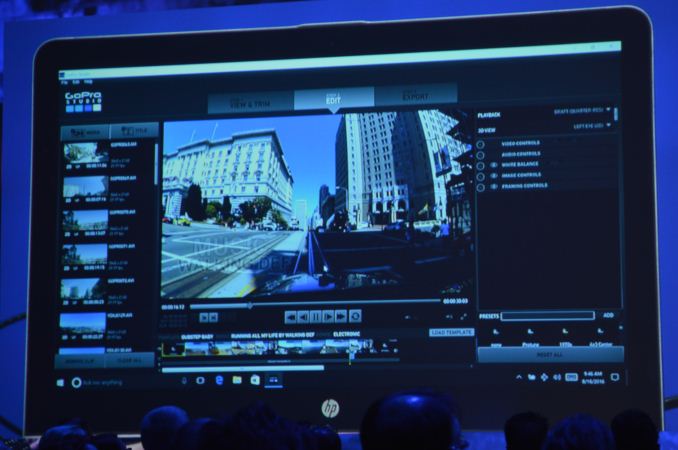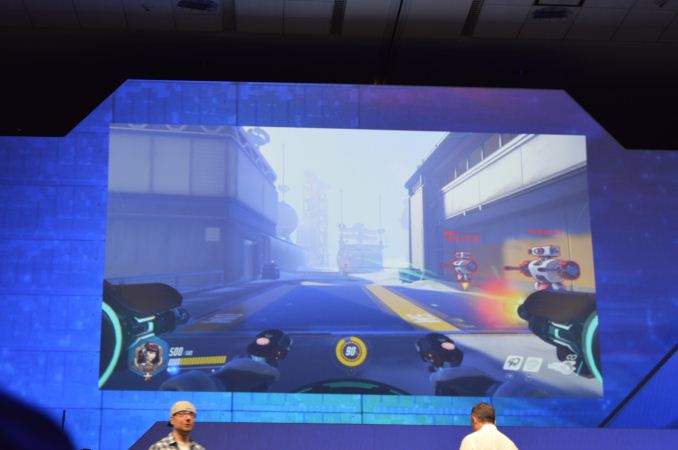Intel Teases Mobile Kaby Lake: HEVC Main10 Profile Support, Coming This Autumn
by Ian Cutress on August 16, 2016 5:59 PM EST
During the Intel Keynote presentation today at IDF Brian Krzanich, CEO of Intel, demonstrated several upcoming Kaby Lake 2-in-1 prototypes from HP and Dell. While no concrete details about the 7th Generation of Intel Core products lines were given, we were offered a couple of bits of information to tide the hype until a full launch.
On the stage, support for HEVC Main10 Profile was announced with 7th Gen, although it was unclear if this was decode only or encode as well. This is still a step up from Skylake support, where Main10 required hybrid hardware/software decoding acceleration. Moving it into hardware for Kaby Lake will help with performance and power consumption, particularly of 4K content where HEVC vs. H.264 differences are bigger than Full-HD. The demo on stage showed GoPro software taking 4K data from six cameras and being able to switch between the content of each camera without stuttering or delay, on a 2-in-1 mobile device.
For gaming, we were treated to a demonstration of Overwatch being run off of the 7th Gen IGP. That being said, it was not mentioned what the resolution or quality the game was running at, and V-Sync was not enabled.
Intel clarified that the demos on the stage were from their highest performance CPUs, but the fact that only 2-in-1s were on display demonstrates that Kaby Lake will be focused on mobile first. The HP and Dell prototypes also add to the ASUS prototypes we saw at Computex earlier in the year. Intel stated that 7th Gen CPUs are already in the hands of partners, ready for production devices, and we should expect to see them in the hands of consumers this autumn. Again, given the focus, it seems we will encounter Kaby Lake in mobile form factors (4W and 15W) before anything on desktop.











35 Comments
View All Comments
Black Obsidian - Tuesday, August 16, 2016 - link
As the owner of an Ivy Bridge-based NUC doing HTPC duty, I've been waiting for HEVC Main10 decode support (and HDMI 2.0) to upgrade. Looks like that'll be happening soon.edzieba - Wednesday, August 17, 2016 - link
Are you sure you haven't been waiting for High Profile 10-bit support, not Main Profile? For media playback (BD and it's UHD successor) on an HTPC, High Profile support is the relevant encoding profile needed for playback.Black Obsidian - Wednesday, August 17, 2016 - link
Full hardware support for High Profile would be ideal, but even partial support would be something. My Ivy Bridge NUC does H265 entirely in software, and chokes on 1080p content if there's any significant amount of on-screen movement.nandnandnand - Tuesday, August 16, 2016 - link
All I care about is how Kaby Lake mobile will do vs. Zen mobile APUs.yannigr2 - Wednesday, August 17, 2016 - link
It will have (much) higher IPC compared to Zen, (much) better energy efficiency compared to Zen and completely destroyed by Zen in the graphics section.psychobriggsy - Wednesday, August 17, 2016 - link
1. Unknown as yet, IPC is likely to be in the same ballpark though (finally!) even if KL edges it by a few percent. Clock speeds at various TDPs and real-life battery usage are what matter in the end and these figures are a way off being tested. Maybe even Cannonlake will be the competition, not KL.2. Unproven as yet - AMD had to implement a lot of energy saving on 28nm APUs and these will be migrated to 14nm APUs
3. Zen is a CPU core and doesn't do graphics. The Zen-based APU will likely use Vega level graphics however, and totally destroy the Intel graphics in all aspects.
TheinsanegamerN - Wednesday, August 17, 2016 - link
vega level would take too much power. something 460 sized would be about as big as a 125 watt APU could take.If they solve the bandwidth problem though, it would still be a major advantage over intel.
MrSpadge - Wednesday, August 17, 2016 - link
By "Vega level" he means it's based on the same architecture level, not the size & performance of the chip.smilingcrow - Wednesday, August 17, 2016 - link
3. Mobile these days generally means 15W or even less so it's not safe to assume that AMD's inherently better graphics prowess will allow them to compete with Intel at these power levels as it depends a lot on how good their fabrication partner is.TheinsanegamerN - Wednesday, August 17, 2016 - link
all massive assumptions, given that intel typically lags behind GPU wise and we have yet to see zen cpus in action.